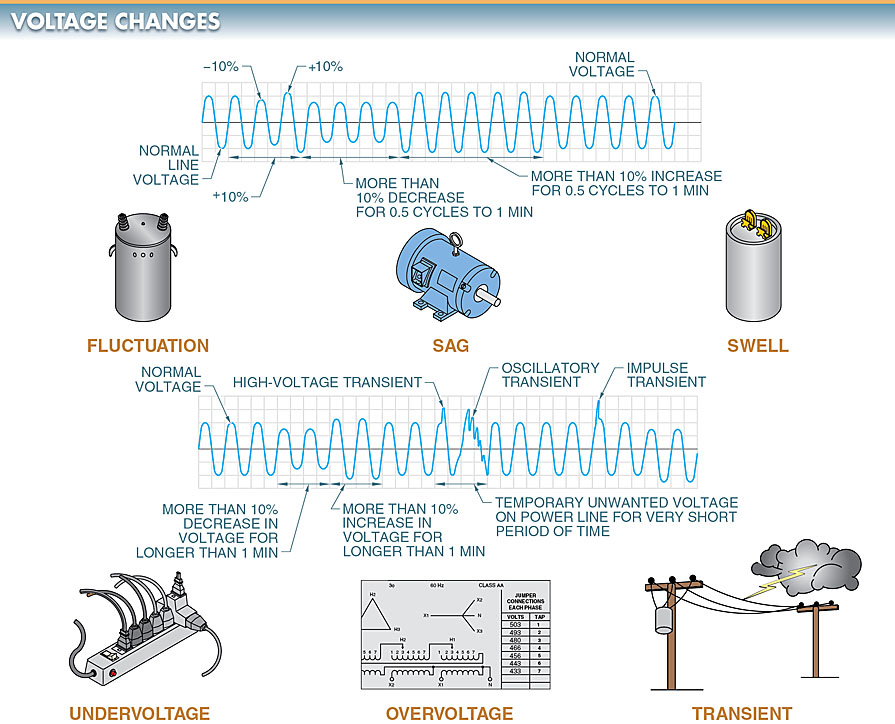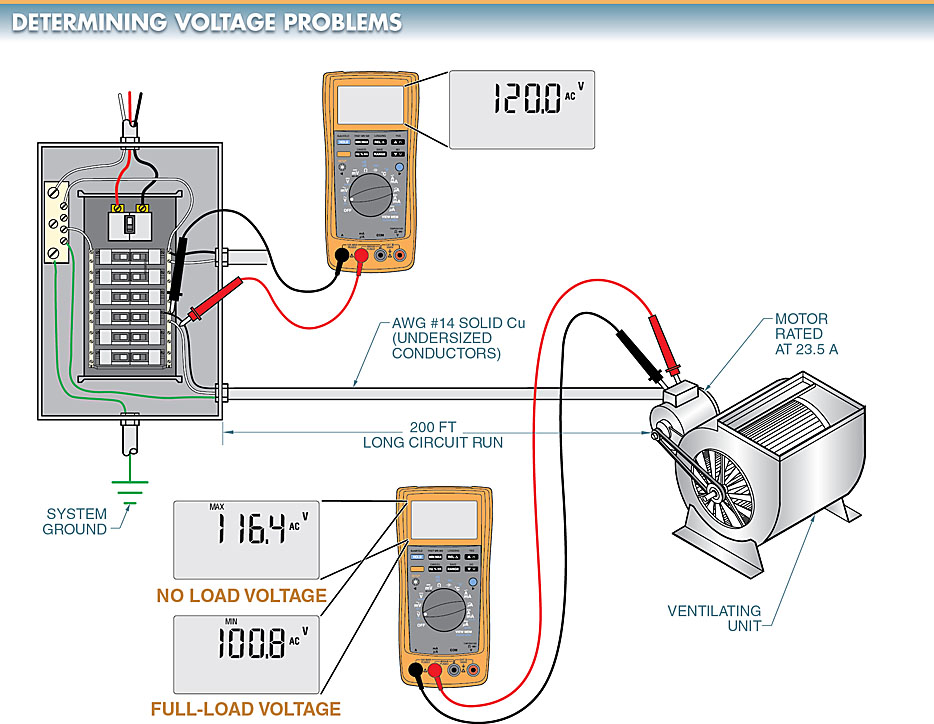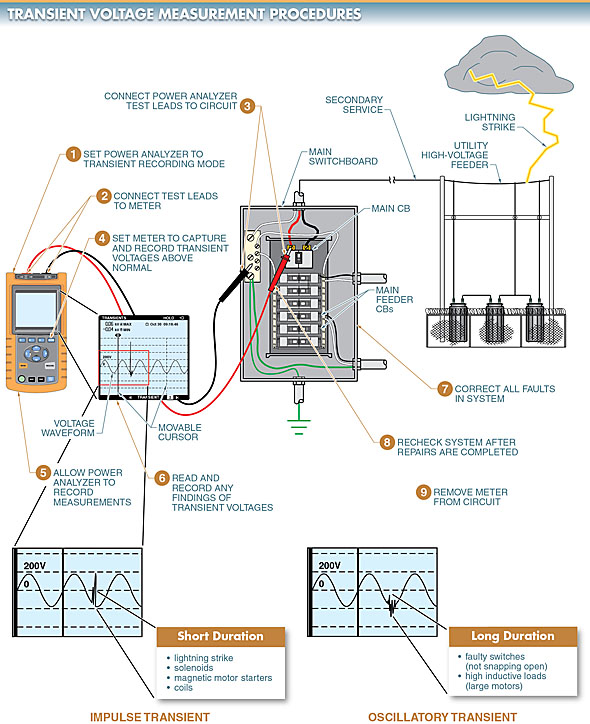All electrical and electronic devices have an optimal operating voltage range and are therefore dependent on the quality of the incoming power to the load.
Instead of a single number, the “rated voltage” is actually a range. The usual margin of error is around 10%. However, the operating voltage range has shifted from +25% to -10%, as many modern components have been derated to reduce power consumption and operating costs. The reason this range is used is because an overvoltage is more dangerous than a low voltage.
Common terms in industry can be applied to the magnitude and frequency of voltage fluctuations. There can be dramatic shifts in voltage, such as a complete blackout, or subtle shifts that last only a few milliseconds (transients).
Power interruptions are classified as momentary, temporary, or sustained power interruption. The different classifications are based on the time power is lost.
A brief blackout occurs when the voltage on one or more lines drops to zero for a duration of 0.5 cycle to 3 seconds.
If the voltage on one or more lines drops to zero for longer than three seconds but less than one minute, there has been a temporary power interruption.
When the voltage on all power lines drops to zero for more than a minute, this is known as a sustained power interruption.
More common than power outages are fluctuations in voltage, which can be a constant source of trouble for appliances. For an example, see Fig. 1.

Voltage Fluctuations
A voltage fluctuation is an increase or decrease in the normal line voltage within the range of +5% to −10%.
Overloaded transformers, unbalanced transformer loading, and high impedance due to long circuit runs, inadequate conductor size, or faulty or loose electrical connections are common causes of voltage fluctuations.
Voltage Sags
A voltage sag is a voltage drop of more than 10% (but not to 0 V) below the normal rated line voltage that lasts from 0.5 cycles up to 1 min.
When high-current loads, like motors, are activated, the voltage often drops. The overcompensation of voltage regulators during a voltage sag caused by the activation of very large motors can lead to a subsequent voltage swell.
If there is a problem with bad connections, a long run, or undersized conductors, a voltmeter can be used to measure the voltage at the power source and at the load.
You can detect a voltage sag or other voltage fluctuation issues by using a voltmeter with a MIN/MAX recording mode to track the voltage over time. The example is in Figure 2.

Voltage Swells
A voltage swell is a voltage increase of more than 10% above the normal rated line voltage that lasts from 0.5 cycles up to 1 min.
When large loads, like motors, are suddenly shut off, the voltage on the power line can spike briefly above the norm (by as much as 10%).
Voltage surges are less common than dips. Voltage swells, on the other hand, are far more destructive than voltage sags because of the rapidity with which they destroy electrical equipment.
Under Voltages
Under voltage is a drop-in voltage of more than 10% (but not to 0 V) below the normal rated line voltage for a period of time longer than 1 min.
Most power outages are caused by undervoltage rather than overvoltage.
Overloaded transformers, inadequately sized conductors, excessively long conductor runs, an excessive number of loads on a circuit, and brownouts are common causes of under voltages.
A brownout is a reduction of the voltage level by a power company to conserve power during times of peak usage or excessive loading of the power distribution system.
Overvoltages
Overvoltage is an increase of the voltage of more than 10% above the normal rated line voltage for a period of time longer than 1 min.
When loads are situated close to a system’s origin or when a transformer’s taps are incorrectly wired, overvoltages result.
A tap is a connection that is taken out of a winding somewhere in the middle, between the ends, to alter the winding’s voltage or current ratio. Standard tap sizes for transformers are 2.5%.
Transient Voltages
A transient voltage (voltage spike) is a temporary, undesirable voltage in an electrical circuit.
Short-term or transient voltages can be anywhere from a few volts to several thousand volts and can last anywhere from a few microseconds to a few milliseconds.
There are two distinct kinds of transient voltages: oscillatory and impulse.
Turning off large utility power factor correction capacitors and other inductive loads can cause a transient voltage with oscillatory characteristics.
Lightning strikes and the disconnection of loads containing coils (such as motor starters and motors) are two common examples of impulse transient voltage.
Transient Voltage Measurement Procedures
Voltage fluctuations are typically tracked with power analyzer meters. Power analyzer meters can retrospectively show the magnitude, period, and timing of transient voltages.
Surge protectors (voltage surge suppressors) must be installed whenever transient voltages are found to be a problem in a building.
A surge protection device is a device that limits the intensity of voltage surges that occur on the power lines of a power distribution system.
Each time an unexpected failure occurs in a piece of equipment and transient voltage is a possible cause, measurements of the voltage spike must be taken. To ensure that surge protectors are functioning properly, transient voltage measurements are taken.
Since the RMS voltage value of a circuit is displayed by the former and the peak voltage value of a circuit is displayed by the latter, it is clear that transient voltage measurements are distinct from standard voltage measurements. In this case, the RMS voltage measurement of the circuit is 115 VACS, which is displayed by a typical voltmeter. About 162 V is the peak voltage in a 115 VAC RMS circuit (RMS voltage multiplied by 1.414 equals peak voltage). View Figure 3.

Transients can damage any electrical or electronic equipment. Transients can also cause problems in electronic circuits without damaging them by producing false signals.
Electronic circuits that rely on low-level digital signals can be disrupted by the high, short-lived voltage spikes as well.
Electronic equipment should have transient protection devices (snubbers) installed at the power line input to check for and dampen the effects of transients.
A good surge suppressor with a rating of at least 1200 Joules can protect electronic devices from transient voltage damage (J).
A power analyzer meter can be used to measure transient voltages, but only if it is calibrated for use on the system being tested.
Follow this procedure to check for transient voltages:
- Switch on the power meter’s transient voltage recording feature.
- If using a power analyzer meter, plug its test leads into the appropriate jacks.
- Bring the voltage test leads from the power analyzer meter into the system under evaluation. The power analyzer meter’s test leads must be connected to the powered system before recording can begin in order to capture transient voltages. Because a power analyzer meter is looking for a voltage greater than the meter’s setting (50%, 100%, 150%, etc.), you must first connect the test leads. The meter will record 50% (or whatever the meter is set to) of nothing if the test leads are not connected before recording begins (0 V).
- The transient voltage recording mode can be activated to capture voltage spikes 50%, 100%, or 200% above the norm. Before the meter is set to record transients, the voltage applied to the test leads is considered normal voltage. A meter set to record transient voltages greater than 100% will register any voltage above 340 V peak when connected to a standard 120 V circuit (120 V RMS multiplied by 1.414 equals 170 V peak, and the meter is set at 100%, so 170 V peak multiplied by 2 equals 340 V peak).
- Switch on and off loads and the meter should keep track of it.
- Examine the data from the recorded transient voltages and make notes.
- Surge suppressors can be used to correct system transients by filtering out transient voltages.
- After the fixes are made, retry the system. Disconnect the power analyzing meter from the circuit.